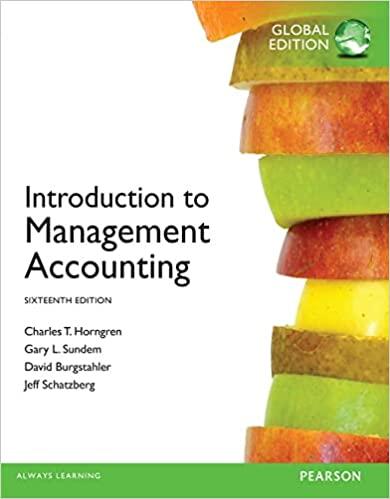Question
The Boston Bread Company bakes baguettes for distribution to upscale grocery stores. The company has two direct-cost categories: direct materials and direct manufacturing labor. Variable
The Boston Bread Company bakes baguettes for distribution to upscale grocery stores. The company has two direct-cost categories: direct materials and direct manufacturing labor. Variable manufacturing overhead is allocated to products on the basis of standard direct manufacturing labor-hours. Following is some budget data for the
Boston Bread Company:
| Direct manufacturing labor use | 0.02 hours per baguette |
|---|---|
| Variable manufacturing overhead | $10.00 per direct manufacturing labor-hour |
The
Boston
Bread Company provides the following additional data for the year ended December 31,
2017
:
| Planned (budgeted) output | 3,700,000 baguettes |
|---|---|
| Actual production | 2,400,000 baguettes |
| Direct manufacturing labor | 42,400 hours |
| Actual variable manufacturing overhead | $555,440 |
.
Requirement 1. What is the denominator level used for allocating variable manufacturing overhead? (That is, for how many direct manufacturing labor-hours is
Boston
Bread budgeting?)
| The denominator level is | hours. |
Requirement 2. Prepare a variance analysis of variable manufacturing overhead.
Begin by calculating the following amounts for the variable overhead that will be used to calculate the variances.
|
|
| Actual Input |
|
|
|
| Actual Costs |
| Flexible | Allocated |
|
| Incurred | Budgeted Rate | Budget | Overhead |
| Variable MOH |
|
|
|
|
Now complete the 4-variance analysis using the amounts you calculated above. (If no variance exists leave the dollar value blank. Label the variance as favorable (F), unfavorable (U) or never a variance (N).)
| 4-Variance | Spending | Efficiency | Production-Volume | |||
| Analysis | Variance | Variance | Variance | |||
| Variable MOH |
|
|
|
|
| |
Requirement 3. Discuss the variances you have calculated and give possible explanations for them.
| The spending variance is |
| because variable manufacturing overhead was |
| % |
| than planned. A possible |
| explanation could be a(n) |
| in energy rates relative to the rate per standard labor-hour assumed in the flexible budget. | ||||
The efficiency variance is
favorable
unfavorable
because the actual number of direct manufacturing labor-hours required was
higher
lower
than the number of hours in the flexible budget. Labor was
less
more
efficient in producing the baguettes than management had anticipated in the budget. This could occur because of
a decline in
improved
morale in the company, which could result from an increase in wages or an improvement in the compensation scheme.
| The flexible-budget variance of |
| is |
| because the efficiency variance was |
| to | ||
| compensate for the spending variance.
| ||||||||
Step by Step Solution
There are 3 Steps involved in it
Step: 1

Get Instant Access to Expert-Tailored Solutions
See step-by-step solutions with expert insights and AI powered tools for academic success
Step: 2

Step: 3

Ace Your Homework with AI
Get the answers you need in no time with our AI-driven, step-by-step assistance
Get Started


